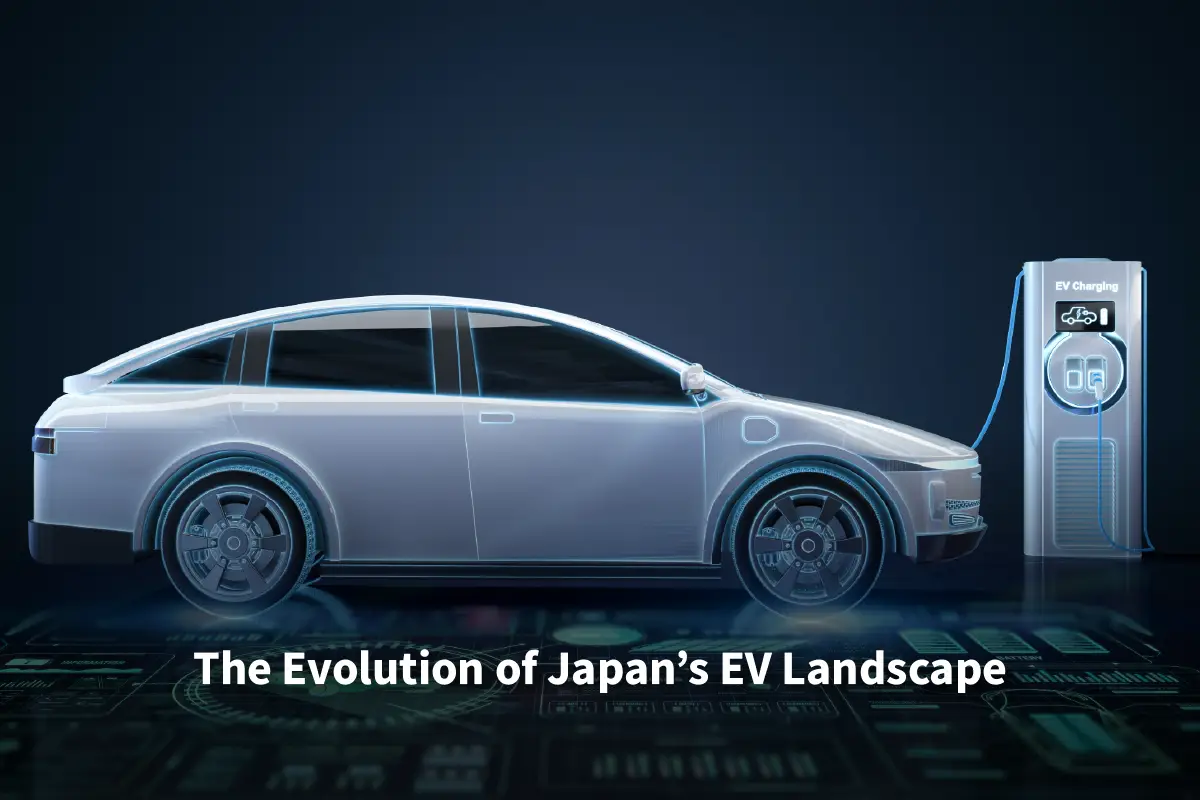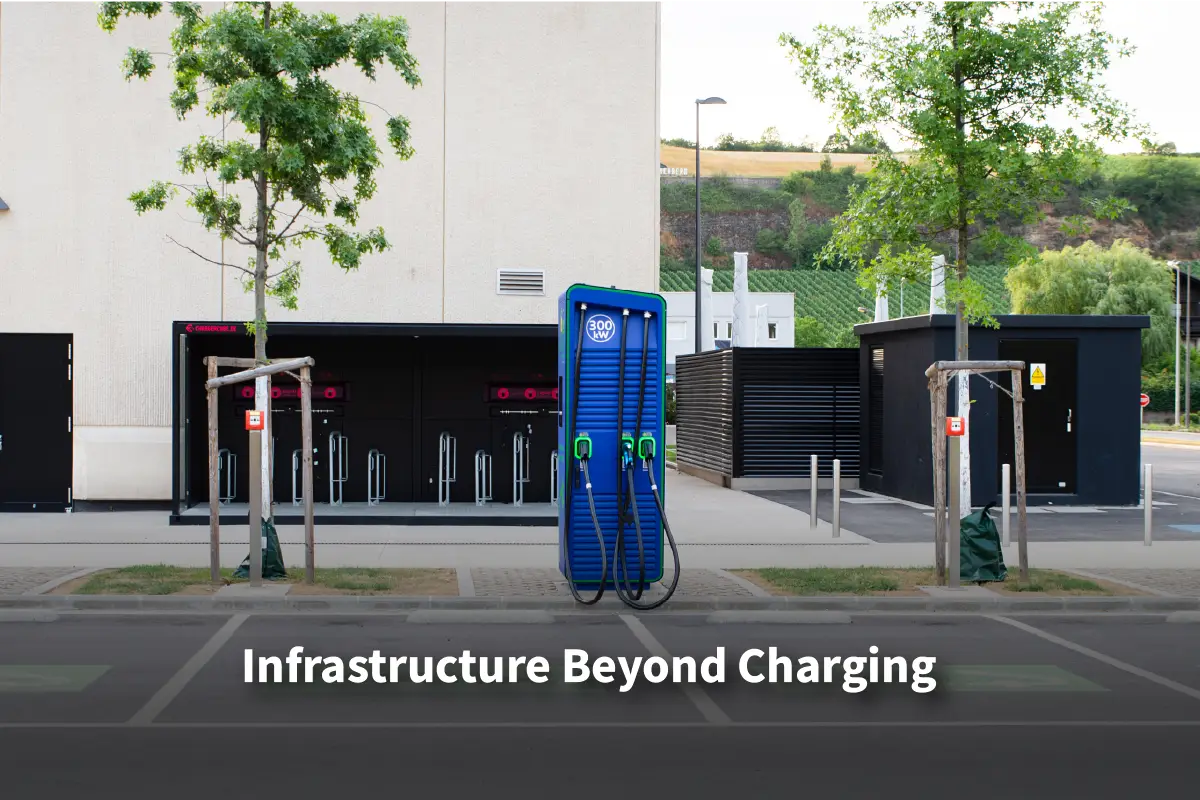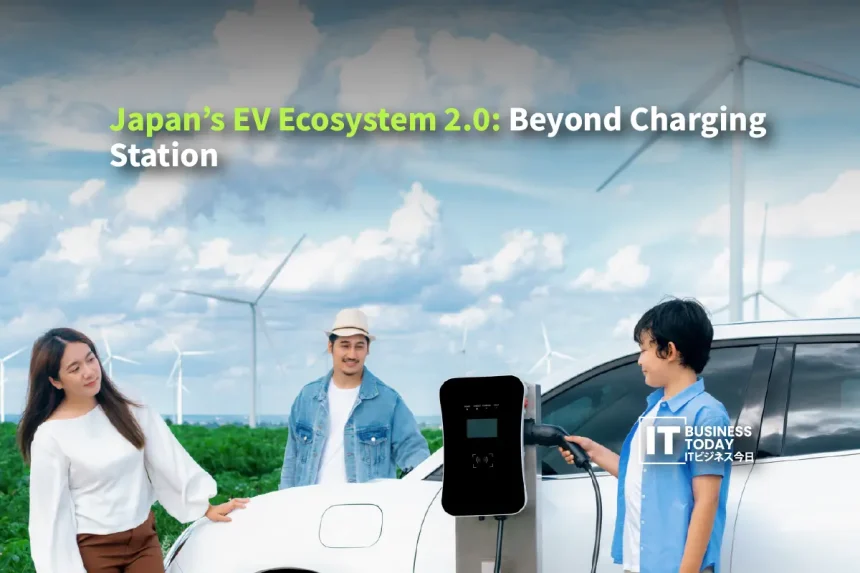日本のEVストーリーは、良い意味で厄介です。彼らはプリウスとホンダ・インサイトでハイブリッド革命をリードし、その後フルバッテリーの電気自動車でスピードバンプにぶつかりました。リーフは確かに画期的でした。しかしその後、日本は逡巡しました。他国は先を急ぎました。日本は安全策をとったのです。
今、状況は変わりつつあります。日本のEVエコシステム2.0へようこそ。自動車だけではありません。充電器だけではありません。政策、研究開発、インフラ、そして自動車メーカーの戦略。自動車は送電網に接続。バッテリーは第二の人生を。政府は単に補助金を提供するだけでなく、持続可能な完全なシステムのための舞台を整えているのです。
すべてがつながるからエコシステムなのです。ソリッド・ステート・バッテリーの試験運用はサイドプロジェクトではありません。ビークル・ツー・グリッドの実験はギミックではありません。インフラは地図上の点ではなく、エネルギー、テクノロジー、モビリティをつなぐものなのです。これが次の段階です。
この国の過去 ハイブリッド 優位性と慎重な採用がテーブルを設定しました。そして今、日本は次の10年を決定的なものにする可能性のあるネットワークを構築し、計画的に動き出しています。EV1.0は始まりにすぎません。エコシステム2.0が本当の勝負。今回、日本は参加するだけでなく、ルールを形成しているのです。
進化する日本のEV事情

これまで見てきたように、日本はEVゲームにつまずいたわけではありません。1990年代後半にトヨタがプリウスを発売し、ホンダがインサイトを発売したのです。ハイブリッド車は瞬く間に日本の名刺代わりとなり、日本は誰もが追いかける技術リーダーと見なされるようになりました。
そして2010年。日産はリーフを発売し、それは単なる電気自動車ではなく、世界初の大衆向け電気自動車となりました。短期間ではありましたが、日本は再び主導権を握り、電動化がどのように拡大できるかを示しました。
他の地域がEVの全面的な普及を推し進める中、日本の自動車メーカーはハイブリッド車に固執しました。ハイブリッド車は安全で、実績もありますが、バッテリー式電気自動車へのシフトを遅らせました。 日本自動車工業会ハイブリッド車の生産台数が圧倒的に多く、BEVはほとんど数字に表れていないのです。国際エネルギー機関(IEA)は、2010年代を通じて日本のEV在庫と市場シェアが中国、欧州、米国に大きく遅れをとっていることを指摘し、世界的にそれを裏付けています。
こちらもお読みください: 三菱電機、自動運転向け「xAUTO」を展開
その歴史が重要なのは、今起きていることの舞台を整えているからです。日本のEVエコシステム2.0。世界的な競争、政策的な圧力、そしてEV需要の紛れもない高まりによって、日本はハイブリッド車のコンフォートゾーンを超えることを余儀なくされています。過去は日本の強みを形成しましたが、同時に遅れを作り出しました。
日本のEVエコシステム2.0とは?
EV1.0はシンプルでした。ハイブリッドを作り、それを売り、イノベーションと呼ぶだけ。世界初の本格的な大衆EVであるリーフでさえ、まだソケットに差し込むだけの車でした。確かに便利。しかし、孤立していました。
日本のEVエコシステム2.0は異なるゲームです。充電ステーションを増やしたり、補助金を推進したりするだけではありません。自動車、エネルギー、政策を結びつける完全なシステムのことです。ここでは「エコシステム」の構築にスポットライトが当てられています。
例えばバッテリー。日本はソリッドステートに大きな賭けをし、国の研究開発費を注ぎ込んで実用化を目指しています。これは副次的なプロジェクトではなく、グローバル・サプライ・チェーンで存在感を発揮し続けるための切符なのです。
次にグリッド。自動車は電力を奪うだけでなく、それを返します。日産の双方向充電パイロットはまさにそれを示しています。自動車は単なる製品ではなく、エネルギー・ミックスの一部になるのです。
そしてループは閉じます。 バッテリー 廃棄物にはなりません。リサイクルされ、再利用され、第二の人生が与えられるのです。環境省はすでにそれを規制の中に組み込んでいます。
日本の2050年カーボンニュートラル計画と結びつければ、EVエコシステム2.0の理由がわかります。充電ステーションを超えて。単に車を売るだけではありません。日本の未来をクリーンなモビリティとエネルギーに閉じ込めるためのシステムなのです。
エコシステム2.0を定義する技術の進歩
日本のEVエコシステム2.0のバックボーンはテクノロジー。そして、ここに明らかな変化があります。
まずはバッテリーから。日本はいつまでもリチウムイオンに固執しているわけではありません。NEDOは全固体電池の研究に資金を提供しており、トヨタとホンダはすでにプロトタイプを試験的に開発しています。これはもう研究所の話ではないのです。生産ラインに向かっているのです。賭けは単純で、ソリッドステートを最初にクラックしたものが、次の10年のEVを制するというもの。
しかし、それは化学だけではありません。デジタルのレイヤーはモビリティにも忍び寄りつつあります。 AI とIoTは、すでにその方法を形成しています。 自動車 は道路、充電ステーション、さらには家庭と接続します。自律走行プロジェクトを加えれば、日本がエコシステムを構築し、自動車が単なる道具ではなく、よりスマートなネットワークのノードになることがわかります。
次にエネルギー。日産はビークル・ツー・グリッド計画を声高に主張しており、そのロードマップは明確です。2026年までに手頃な価格の双方向充電を商業化。それは車の役割を反転させます。もはや電力を引っ張るだけでなく、送電網を安定させ、家庭をバックアップし、エネルギーを売り戻すことさえできるのです。
世界的にはどうなのでしょうか?米国は急速に規模を拡大し、中国は猛スピードであらゆるものを建設し、韓国は積極的に追いかけています。日本はスピードは遅いですが、ユニークです。大量生産に走るのではなく、精密な先進バッテリー、デジタルモビリティ、エネルギー統合を倍増させています。
それがエコシステム2.0の定義です。ただ追いつくだけでなく、他の企業にはない忍耐力や専門知識を駆使して技術レイヤーを構築すること。
政府の方針と戦略目標
日本のEVエコシステム2.0は市場主導型ではなく、政策主導型です。政府は、積極的な支援がなければEVの普及が停滞することを知っています。そのため、2024年度のクリーンエネルギー自動車(CEV)補助金制度は約 1,291億円対象となるBEVの1台あたりの支援額は85万円近くに達します。その計算は明らかで、初期費用の負担を軽減すれば、より多くの人がEVに乗るようになります。
もうひとつのテコはインフラ。経済産業省の「EV充電インフラ整備促進ガイドライン」(2023年10月)は、そのロードマップを示しています。単に充電器を都市部に点在させるのではなく、高速の公共ステーション、職場での充電、次世代バッテリーに対応した技術標準が焦点となっています。これがなければ、最先端のEVでさえ行き詰まってしまいます。
政策も孤立しているわけではありません。日本のEV戦略は、2050年までにカーボン・ニュートラルを達成することを目標とする戦略的エネルギー計画に直接組み込まれています。その論理は単純で、送電網を脱炭素化し、車両を電動化し、電力部門の改革と同期して輸送の排出量を削減するというものです。
電池は国家安全保障。経産省とNEDOは、輸入への依存を減らすため、国内生産ラインとサプライチェーン・プロジェクトに資金を提供しています。これには、先端材料、リサイクルシステム、そして最終的には全固体電池のスケーリングに対する補助金も含まれます。リサイクルは後付けではなく、中核的な産業戦略として枠組みに組み込まれています。
つまり、需要を喚起するための補助金、それを可能にするインフラ、長期的な気候変動目標と結びついた政策、そして日本をゲームに参加させ続けるためのバッテリー戦略です。エコシステム2.0は、短期的な勝利よりも、日本のモビリティの未来を維持できるシステムの構築に重点を置いています。
エコシステムを牽引する市場プレイヤー
日本のEVエコシステム2.0を現実のものにするのは自動車メーカーです。各社が独自のプレイブックを持っています。
トヨタは明らかにヘビー級。他社がBEVに全力投球する中、トヨタはハイブリッド、プラグイン、燃料電池、そして今回のバッテリー電気自動車と、マルチパスへの賭けを続けました。批評家はそれを慎重と呼びますが、トヨタはヘッジと呼んでいます。現在際立っているのは、NEDOプロジェクトに支えられた固体電池への投資で、すでにパイロット試験が進行中。トヨタが実現すれば、EV性能のタイムラインはリセットされるかもしれません。
日産は違う道を選びました。リーフは、大衆市場向けEVで日本に早くから自画自賛の権利を与えました。そして今、日産はビークル・ツー・グリッドに大きく舵を切っています。2026年までに手頃な価格の双方向充電を実用化するというロードマップは、単なる技術的誇大宣伝ではありません。
ホンダと三菱は提携を重視。ホンダにとっては、バッテリーの共同開発やパートナーと共有するEVプラットフォーム。三菱は、特に小型EVで競争力を維持するために、グローバルな協力関係を結んでいます。
そして、業界の代弁者である自工会。その生産・販売データは、ハイブリッド車に比べてBEVの普及が遅れていることを強調しています。しかし、シフトが起こっていること、台数が増加していること、政策の圧力がカーブを加速させていることも示しています。
供給面では、グローバルな協力関係が重要です。パナソニックは依然としてトヨタのバッテリーの頼みの綱であり、日産やホンダはCATLやUS/EUイニシアティブのようなパートナーに注目しています。日本は単独でこのエコシステムを構築しているわけではありません。
充電以外のインフラ

充電ステーションが最初の一歩であることは明らかですが、日本のEVエコシステム2.0はプラグだけではありません。経済産業省は、公共施設や急速充電器の配備について野心的な目標を設定しましたが、数字が物語るのは、爆発的な成長ではなく、着実な成長です。現場の現実は、都市や高速道路が依然として格差に直面していることであり、そのため、量よりも戦略的な配置が重要なのです。
スマートグリッドが注目されています。日産が主導し、NEDOと経済産業省の資金援助を受けて実施されているビークル・ツー・グリッドのパイロット試験では、EVが電力供給を安定化させ、ピーク時に電力を供給し、再生可能エネルギーとシームレスに統合できることが示されています。日本のエネルギーシステムは、単に自動車を受け入れるだけのものではありません。今や自動車はエネルギーシステムの一部なのです。
リサイクルはもうひとつの柱です。環境省はバッテリーの再利用とリサイクルの枠組みを正式に定めており、自動車メーカーはすでにセルを再生し再利用する企業イニシアチブを実施しています。バッテリーは埋立地で死ぬだけでなく、家庭や商業用送電網で第二の人生を送り、ループを閉じて環境への影響を減らします。
水素と代替燃料は、このインフラ方程式の静かな一部です。燃料電池自動車はまだニッチですが、日本は燃料補給ステーションや産業支援を通じて水素のエコシステムを維持しています。このアプローチは補完的です。EVが主役ですが、水素はバッテリーだけではカバーできないギャップを埋めるものです。
これらの動きを総合すると、日本は第一世代よりもスマートで統合されたEVシステムを構築していることがわかります。それは充電器の数を数えることではなく、エネルギー、モビリティ、そして持続可能性を機能する全体へとつなげることなのです。
世界との関連性と日本の競争力
日本のEVエコシステム2.0は真空地帯には存在しません。世界的に見れば、その状況は混雑しており、動きも速い。米国はインフレ抑制法の下でインセンティブに大きく傾き、欧州は厳しいCO₂目標で55のためのフィットをプッシュし、中国は新エネルギー車政策を通じて大量に推進しています。
日本は、数の上ではこれらのプレーヤーには及びません。EVの普及率はまだ控えめで、公共充電の密度は中国やヨーロッパの一部に後れを取っています。このギャップが、批評家たちが強調する「遅れ」であり、技術力で知られる日本にとっての明確な課題なのです。
しかし、精密さが重要な分野では日本がリードしています。NEDOと自動車メーカーのパイロット事業を通じて調整されている固体電池の研究は、次世代のエネルギー貯蔵において日本をリードしています。2026年までに日産自動車が商業化するビークル・ツー・グリッド・プログラムは、大規模に再現できる国がほとんどない統合性を示しています。リサイクルとセカンドライフ・バッテリー・プログラムも、日本を持続可能なEVシステムの最前線に位置づけています。
要するに、日本のEV競争は台数競争ではありません。先進技術を駆使し、循環型システムを構築し、モビリティとエネルギー・グリッドを統合することなのです。競合他社は今日、日本を上回ったり上回ったりしているかもしれませんが、技術的な深みとエコシステムの洗練という点で、日本は独自のレースを展開しています。
前途(2025~2035年)
日本はようやくハイブリッドの快適ゾーンから一歩踏み出そうとしています。EVの普及は間違いなく進むでしょう。 国際原子力機関 上向きの突起。しかし、上り坂は平坦ではありません。EVの普及率は依然として中国やヨーロッパに遅れをとっています。このギャップは政策だけでは解決できません。
固体電池は大きな賭け。NEDOの支援を受けたトヨタとホンダは、プロトタイプを強力にプッシュしています。実用化は2020年代後半。うまくいけば、航続距離は延び、充電時間は短縮され、日本は他国がうらやむ技術的リードを持つことになるでしょう。失敗すれば、遅れはさらに大きくなります。
次は手頃な価格のEV。自動車メーカー各社は輸出を視野に入れながら、国内ラインを拡大しています。これは日本のマルチパス戦略が功を奏するところです。
そしてサプライチェーン。バッテリー、レアアース、リサイクル......日本は単に車を作っているのではなく、システムのインプットとアウトプットをコントロールしているのです。セカンドライフ・バッテリー、産業リサイクル、国内生産、これらは余分なものではありません。世界的な関連性を維持するための核となるものなのです。
今後10年が勝負。日本は技術的な深みを実際の普及につなげるか、それともリードが崩れるのを見守るか。それこそがEVエコシステム2.0の本質です。
結論
日本のEVエコシステム2.0は、単なる電気自動車の普及ではありません。バッテリー、送電網、リサイクル、政策、これらすべてが一体となった、実際に機能するシステムを構築することです。これが、「充電ステーションの先にあるもの」が重要な理由です。自動車のプラグインは簡単です。弾力性があり、拡張性があり、将来も大丈夫なエコシステムを作るのは?それは難しい。
政策が需要を後押し。研究開発が技術を後押し。そしてインフラがすべてを結びつけます。日本は世界的なEV論議で最も大きな声を上げる国ではありませんが、その必要はありません。日本の強みは精密さ、計画性、そして統合性にあります。ソリッド・ステート・バッテリー V2G循環型リサイクルこれらは無作為の取り組みではなく、競合他社よりも長持ちするエコシステムのバックボーンなのです。
次の10年はこの戦略が試されます。しかし、日本が同調して動き続ければ、EV革命に参加するだけでなく、その一部を静かに定義することになるでしょう。日本が最初にEV市場に参入することはないかもしれませんが、将来EVが必要とされるとき、その準備はできているはずです。







